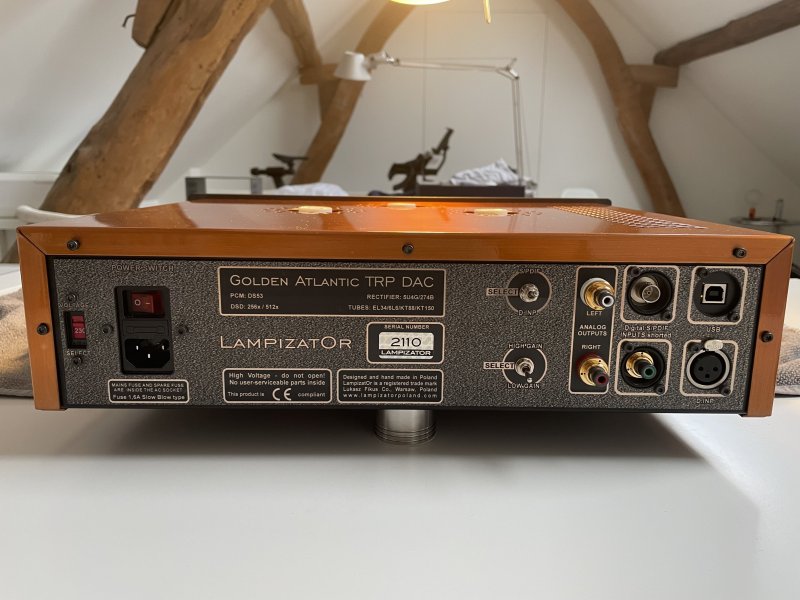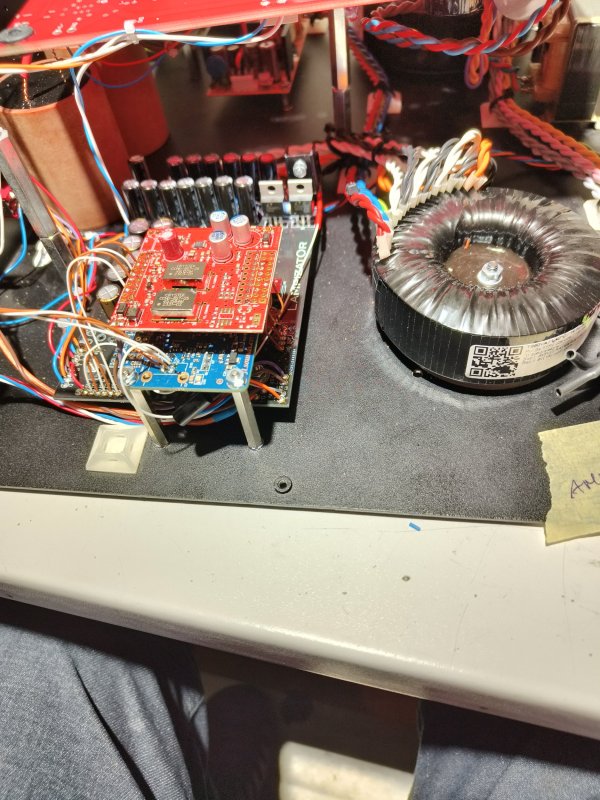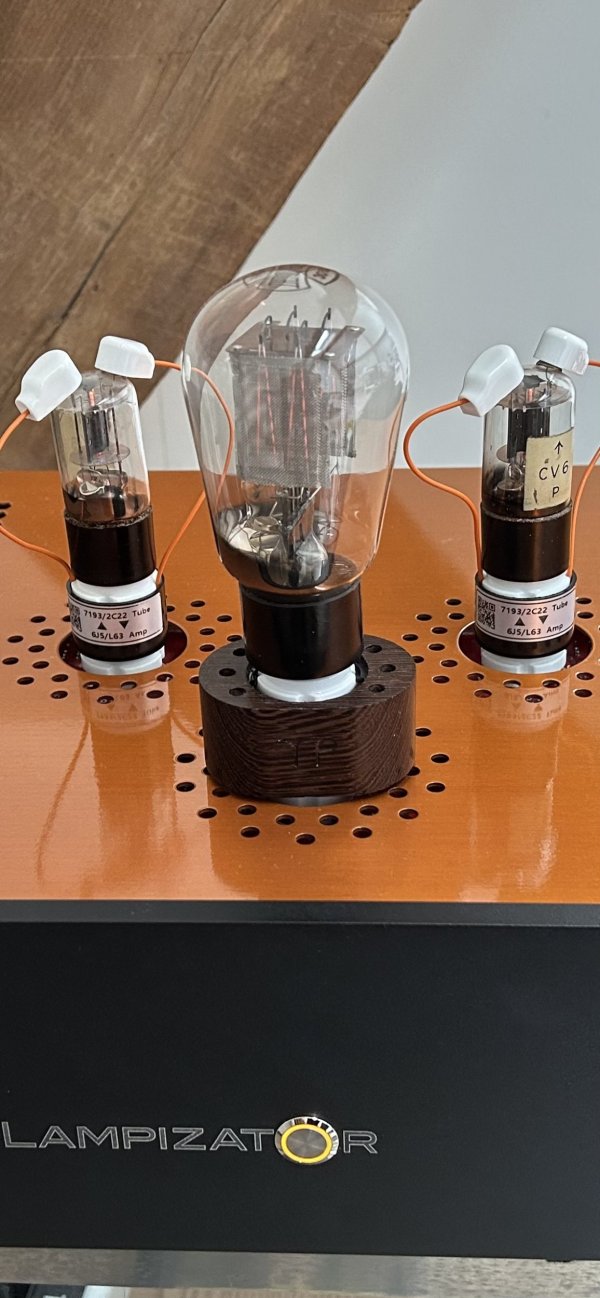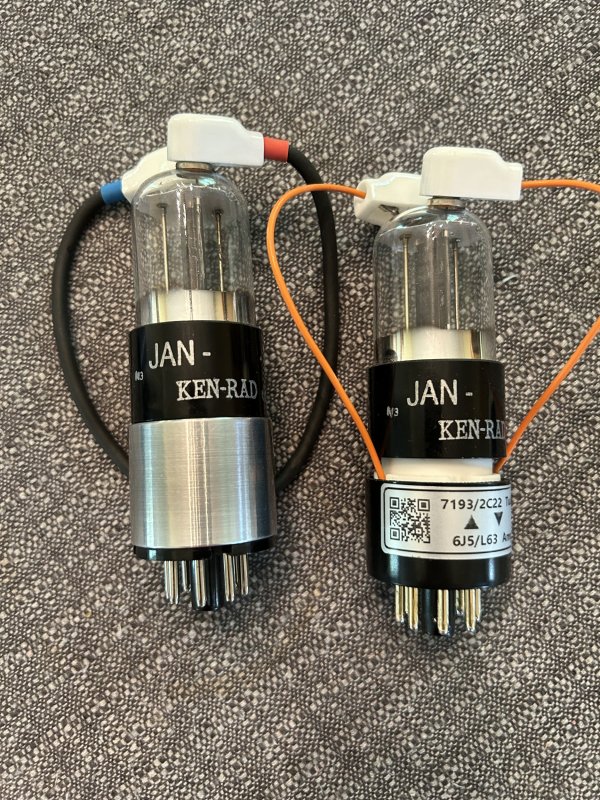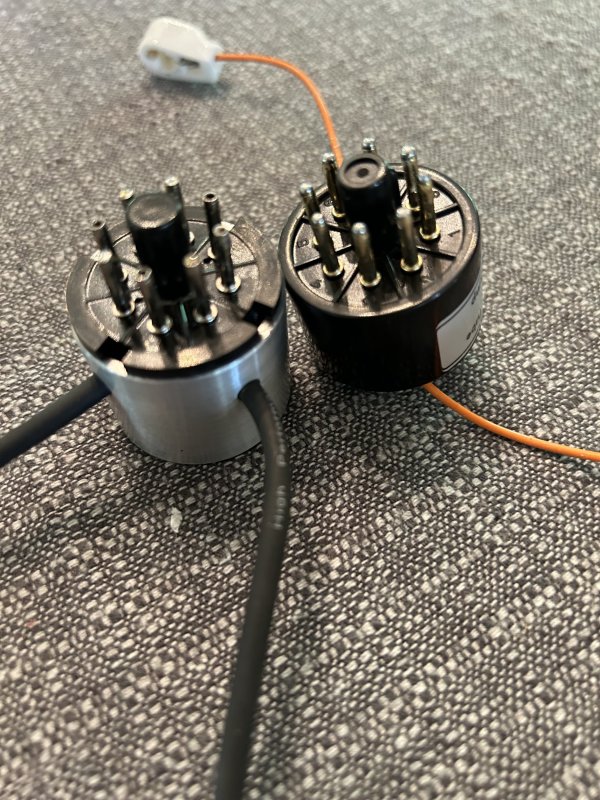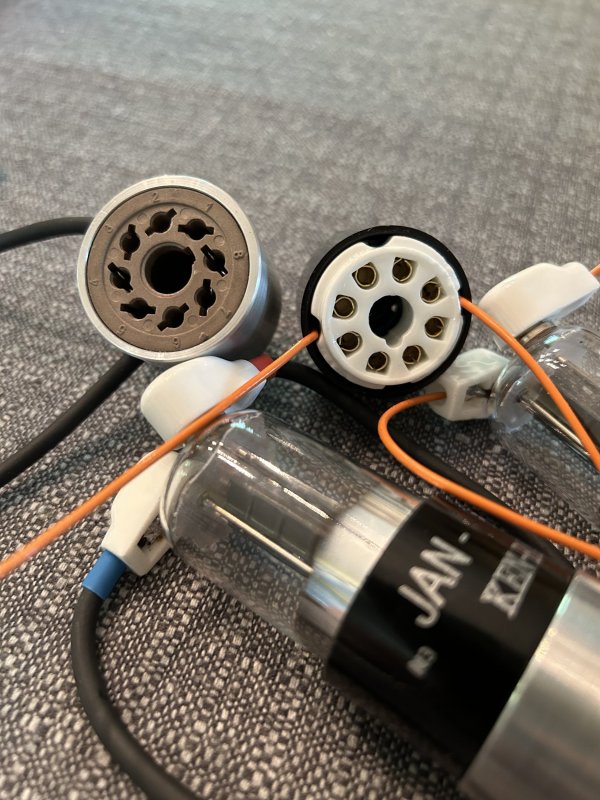They look interesting… My A3 had the same plastic with rubber rings on the bottom as mentioned above (they seem pretty cheap). I replaced them with some ingress engineering roller balls to good effect. I really like decoupling in theory and practice - those little Ingress guys are a good sounding solution under my switch and turntable along with my Lampi.View attachment 129796
When I had a TRP it came w/ 3 silver cylindrical Stacore feet, and I found out they are supposed to sit on top of these spike-plates as part of their isolation design. Strangely, though, it did not come with my TRP nor my GA TRP -- I tried to buy them but they were not available for sale by themselves. These are left over from my Pacific 2's Stacore feet.
If anyone's interested let me know.
LampizatOr Golden Atlantic + TRP
- Thread starter Golum
- Start date
You are using an out of date browser. It may not display this or other websites correctly.
You should upgrade or use an alternative browser.
You should upgrade or use an alternative browser.
@WjhenThanks designsfx. I have read your comments on the Sylvania VT94. I had already ordered the adapters for the CV6 tubes from the source you linked in your message. They are on their way.
What I would like is an indirectly heated triode alternative for the Siemens F2a. Buburna stated that the Tungsol VT94 was that kind of tube. Is the Sylvania VT94 such as tube? I listen mostly to large orchestral music and opera, I therefore like air, soundstage, transparancy and such. I do not need 'warm and cosy'.
The WE350B is a great tube: lush but airy and great soundstage. If only deep bass control could be just a little bit better. That is maybe because they are also a bit microphonic. I may need some dampers for that to solve the issue.
By the way, Engine 11-p has now more than 200 hours on it, and it still improves. The sound becomes less 'edgy and staccato' , more easy on the ear. That will serve the F2a tubes well. My Lazlo adapters for the F2a are on its way. So, F2a may still be in the mix. We will see.
I just noticed your F2a’s and adapters up for sale- looks like you’re going in a different direction? Which tubes are working best for you now?
Yes, I am going in a different direction. As I said earlier, I loved the F2a with TRP-2 but with the TRP with engine 11-p they are too dynamic and forward. I listen with headphones, mostly large scale orchestral music and opera. It was too much. With TRP-2 it was fantastic.
At the moment I like the WE350B , and I took the bait of Budburma on the CV6 tubes. I have bought two sets of GEC CV6 and one set Mullard CV6. I just started to play with them. So far very promising. Will tell more once they have decent burn in and playtime. There is already a lot of info on the CV6 to be found on head-fi.
At the moment I like the WE350B , and I took the bait of Budburma on the CV6 tubes. I have bought two sets of GEC CV6 and one set Mullard CV6. I just started to play with them. So far very promising. Will tell more once they have decent burn in and playtime. There is already a lot of info on the CV6 to be found on head-fi.
As some of you might know, at the moment I have 2 Lampizators dacs at home: the Golden Gate SE with engine 11-p and the Golden Atlantic TRP with Engine 11-p. The Atlantic also has upgraded output capacitors: Duelund Cast Copper 1.0uF bypassed with 0.1uF Jupiter Comet pure silver. Because of its size I am (more or less) forced to sell the Golden Gate. For me, the Golden Gate with engine 11-p, Philips PT14 and Telefunken RGN2004 mesh is absolutely perfect with the music I listen to most. It has a huge soundstage, very detailed but not upfront. Great imaging, air, bass definition, and always fully in control no matter how frantic the music gets. It just fits large orchestral music and opera extremely well. It is impressively unimpressive. It just plays, and from that moment on I just listen and listen. Every time I use it I immediately feel at ease. I am glad it did not sell yet, and I still very much contemplating how to fit it into our small new house.
So my back up plan was, instead of selling the TRP to finance the Golden Gate, to upgrade it with a similar engine as the Golden Gate. So I chose engine 11-p instead of the usual engine 11 and asked Lampizator to install the Duelund Cast copper 1.0uF and the 0.1 Jupiter silver comet as bypass. Idea was to get as close as possible to the Golden Gate sound. Well, wake up call, the Atlantic TRP will never sound as the Golden Gate. It is a different beast all together. And trying to copy the sound is wasting its virtues. I have to accept that the Golden Atlantic TRP is more or less the younger brother of the Golden Gate. It is not as mature and in control. It is a bit ‘out of hand’ and ‘exciting’. It is the Georg Solti of Dacs, whereas the Golden Gate is more Karajan if that makes sense. With Golden Gate you feel the tension in the music building up, you feel the room pressurize. It slowly builds up and prepares your what is about to happen. With Golden Atlantic TRP you do not receive such warning, you are taken for a ride and it is a blast. I have spent a week trying different tube combinations. I will report the results below.
Siemens F2a
I have struggled a lot with this tube. Strange as it was by far my favourite in the TRP2. It is an exceptionally clear tube sound. You hear very deep into the recording, as if an extra layer of haziness is removed. A very transparent sound. It has great presence, great resolution, great bass and bass control. A very transparent, open sounding tube. But…..it proves to be very rectifier dependent.
I first used it with the Telefunken RGN2004 mesh. That is generally the best rectifier in my collection. Clear, dynamic, detailed, refined. So I thought it should fit the F2a well. Not in my system. It is too exciting and I do not say that lightly. For some reason there is not enough depth in the sound. There is not enough foreground-background. It is very upfront, too much so. To be honest, because I was accustomed to the elegance of the Golden gate I could not stand it at all, I just put them on sale with my newly acquired TP adapters….Fortunately I did some more experiments over the weekend. First, it mellows down by using the low gain setting. Still dynamic and upfront but much less than in the high gain setting. I could live with this. If lower gain is the route with the Mesh plate I will do more experiments where to lose gain: in the dac using the low gain setting or in the amplifier because I can use a lower gain driver tube in my 300B amplifier: the E180F instead of the D3a for instance.
Then I tried my reference in the TRP-2, the Elrog 274B. That brought me back to the sound of the F2a I know well. And the difference is quite shocking. The Elrog 274B is nowhere near as upfront and dynamic as the RGN2004 mesh. I set the DAC in its high gain setting and this is well balanced, dynamic, detailed, pleasant, exciting but for the mere mortals. I could live with this combination easily. But strangely enough I also missed some of the excitement of the RGN2004 mesh….I preferred the RGN2004mesh in low gain setting over the Elrog 274B in high gain with the F2a.
Next I tried the Telefunken RGN2004 solid plate. That came as an absolute shocker. The soundstage increased enormously. I used it in high gain setting. A gigantic soundstage, lots of air, and much more depth in the sound. Just much more 3D than the Telefunken RGN2004 mesh. The sound is as clear as a clear blue sky. That changed my perspective on the F2a because now it has enough room to show its stuff. That is what the F2a needed. Now do not get me wrong, in the high gain setting it is still very dynamic and very exciting. But I can handle now. More so, I am loving it. If you want clarity, a clear view, all the details of the recording revealed, than this is the ticket. It shows you all the flaws in the recording as well, but who cares. The TRP with engine 11-p, Siemens F2a and RGN2004 solid plate is the out of control younger brother of the Golden Gate with engine 11-p, PT14 and RGN2004 mesh.
Moral of the story so far, I keep the F2a tubes. But I also started to explore the Indirectly heated triodes. Thanks to Designfx and Budburma. Based on their comments I focused on the CV6 tubes.
GEC CV6
The GEC CV6 maybe has just a bit less resolution than the f2a and PT14. With The F2a and PT14 you really hear when the bow of the violin touches the snare, it has bite. With the GEC CV6 you do not hear that as well. But what the GEC CV6 offers, compared to the F2a, is a very nice sonority, you hear more of the resonances of the wooden body of the violin. That is in a nutshell the difference. The GEC CV6 has a bit less bite but more sonority than the F2a. But don’t even think that this is a warm, cosy, fireplace kind of tube. It is very detailed, dynamic, has great bass depth and control. And remember I compare it with the F2a tube which is together with the PT14 the clearest and cleanest tube sound I know of.
The GEC CV6 with the Telefunken RGN2004 mesh is a fantastic combination. The CV6 brings a lot of depth in the soundstage, much more than the F2a. For some reason that is what the Telefunken RGN2004 mesh needs because the sound is much less forward than with the F2a. There is room to breathe. This depth in the soundstage enables you to feel the tension of the music building up, similar to the PT14 in the Golden Gate. The RGN2004 mesh with the GEC CV6 excel at tonal refinement, naturalness. It has great resolution and detail but it misses the absolute clearness and clarity of the F2a with the RGN2004 solid plate. The tonality is a bit warmer for lack of a better word. It also misses the iron fist control of the F2a in the orchestral tuttis. Do not worry, no tube that I know of has the type of control the F2a has. Control is perfectly fine, but this combination excels in the quieter parts of he music. In that sense it reminds me a bit of the conductor Giulini in Bruckner. I very much love this combination. Totally different than the F2a with RGN2004 solid plate. More humanly sane so to speak, but oh boy that combination F2a and RGN2004 solid plate is exciting…..
Next I tried the GEC CV6 with Telefunken RGN2004 solid plate. For some reason it did not result in the same enormous increase in soundstage width as it did with the F2a. It sounded harder, less elegant than the RGN2004 mesh. I very much preferred the mesh plate with the GEC CV6.
I still have a lot of experimenting to do. I have now tested the GEC CV6 Shaw (P), but on its way is the GEC CV6 Hammersmith (Z), and I also have the Mullard CV6 (red label) at hand. And many other rectifiers…I will come back to discuss the different type of CV6 tubes. Hope this was helpful for now.
So my back up plan was, instead of selling the TRP to finance the Golden Gate, to upgrade it with a similar engine as the Golden Gate. So I chose engine 11-p instead of the usual engine 11 and asked Lampizator to install the Duelund Cast copper 1.0uF and the 0.1 Jupiter silver comet as bypass. Idea was to get as close as possible to the Golden Gate sound. Well, wake up call, the Atlantic TRP will never sound as the Golden Gate. It is a different beast all together. And trying to copy the sound is wasting its virtues. I have to accept that the Golden Atlantic TRP is more or less the younger brother of the Golden Gate. It is not as mature and in control. It is a bit ‘out of hand’ and ‘exciting’. It is the Georg Solti of Dacs, whereas the Golden Gate is more Karajan if that makes sense. With Golden Gate you feel the tension in the music building up, you feel the room pressurize. It slowly builds up and prepares your what is about to happen. With Golden Atlantic TRP you do not receive such warning, you are taken for a ride and it is a blast. I have spent a week trying different tube combinations. I will report the results below.
Siemens F2a
I have struggled a lot with this tube. Strange as it was by far my favourite in the TRP2. It is an exceptionally clear tube sound. You hear very deep into the recording, as if an extra layer of haziness is removed. A very transparent sound. It has great presence, great resolution, great bass and bass control. A very transparent, open sounding tube. But…..it proves to be very rectifier dependent.
I first used it with the Telefunken RGN2004 mesh. That is generally the best rectifier in my collection. Clear, dynamic, detailed, refined. So I thought it should fit the F2a well. Not in my system. It is too exciting and I do not say that lightly. For some reason there is not enough depth in the sound. There is not enough foreground-background. It is very upfront, too much so. To be honest, because I was accustomed to the elegance of the Golden gate I could not stand it at all, I just put them on sale with my newly acquired TP adapters….Fortunately I did some more experiments over the weekend. First, it mellows down by using the low gain setting. Still dynamic and upfront but much less than in the high gain setting. I could live with this. If lower gain is the route with the Mesh plate I will do more experiments where to lose gain: in the dac using the low gain setting or in the amplifier because I can use a lower gain driver tube in my 300B amplifier: the E180F instead of the D3a for instance.
Then I tried my reference in the TRP-2, the Elrog 274B. That brought me back to the sound of the F2a I know well. And the difference is quite shocking. The Elrog 274B is nowhere near as upfront and dynamic as the RGN2004 mesh. I set the DAC in its high gain setting and this is well balanced, dynamic, detailed, pleasant, exciting but for the mere mortals. I could live with this combination easily. But strangely enough I also missed some of the excitement of the RGN2004 mesh….I preferred the RGN2004mesh in low gain setting over the Elrog 274B in high gain with the F2a.
Next I tried the Telefunken RGN2004 solid plate. That came as an absolute shocker. The soundstage increased enormously. I used it in high gain setting. A gigantic soundstage, lots of air, and much more depth in the sound. Just much more 3D than the Telefunken RGN2004 mesh. The sound is as clear as a clear blue sky. That changed my perspective on the F2a because now it has enough room to show its stuff. That is what the F2a needed. Now do not get me wrong, in the high gain setting it is still very dynamic and very exciting. But I can handle now. More so, I am loving it. If you want clarity, a clear view, all the details of the recording revealed, than this is the ticket. It shows you all the flaws in the recording as well, but who cares. The TRP with engine 11-p, Siemens F2a and RGN2004 solid plate is the out of control younger brother of the Golden Gate with engine 11-p, PT14 and RGN2004 mesh.
Moral of the story so far, I keep the F2a tubes. But I also started to explore the Indirectly heated triodes. Thanks to Designfx and Budburma. Based on their comments I focused on the CV6 tubes.
GEC CV6
The GEC CV6 maybe has just a bit less resolution than the f2a and PT14. With The F2a and PT14 you really hear when the bow of the violin touches the snare, it has bite. With the GEC CV6 you do not hear that as well. But what the GEC CV6 offers, compared to the F2a, is a very nice sonority, you hear more of the resonances of the wooden body of the violin. That is in a nutshell the difference. The GEC CV6 has a bit less bite but more sonority than the F2a. But don’t even think that this is a warm, cosy, fireplace kind of tube. It is very detailed, dynamic, has great bass depth and control. And remember I compare it with the F2a tube which is together with the PT14 the clearest and cleanest tube sound I know of.
The GEC CV6 with the Telefunken RGN2004 mesh is a fantastic combination. The CV6 brings a lot of depth in the soundstage, much more than the F2a. For some reason that is what the Telefunken RGN2004 mesh needs because the sound is much less forward than with the F2a. There is room to breathe. This depth in the soundstage enables you to feel the tension of the music building up, similar to the PT14 in the Golden Gate. The RGN2004 mesh with the GEC CV6 excel at tonal refinement, naturalness. It has great resolution and detail but it misses the absolute clearness and clarity of the F2a with the RGN2004 solid plate. The tonality is a bit warmer for lack of a better word. It also misses the iron fist control of the F2a in the orchestral tuttis. Do not worry, no tube that I know of has the type of control the F2a has. Control is perfectly fine, but this combination excels in the quieter parts of he music. In that sense it reminds me a bit of the conductor Giulini in Bruckner. I very much love this combination. Totally different than the F2a with RGN2004 solid plate. More humanly sane so to speak, but oh boy that combination F2a and RGN2004 solid plate is exciting…..
Next I tried the GEC CV6 with Telefunken RGN2004 solid plate. For some reason it did not result in the same enormous increase in soundstage width as it did with the F2a. It sounded harder, less elegant than the RGN2004 mesh. I very much preferred the mesh plate with the GEC CV6.
I still have a lot of experimenting to do. I have now tested the GEC CV6 Shaw (P), but on its way is the GEC CV6 Hammersmith (Z), and I also have the Mullard CV6 (red label) at hand. And many other rectifiers…I will come back to discuss the different type of CV6 tubes. Hope this was helpful for now.
Last edited:
Nice report @Wjhen - thank you so much. I can hear your descriptions well.
I'm curious, are your GEC's ST or straight glass? Maybe you can post a pic or two of the GEC's and Mullard's. My ST GEC's and Mullards are more alike than different and more gentlemanly than their american sibling.
I'd encourage you to try some WWII era Ken-Rad 7193's to compare with them. I find the KR to be more dynamic with a deeper still tuneful bass. Also, the Tungsol VT94D has the kind of clarity and delineation you seem to appreciate - it makes sense with large scale orchestral works, too.
I'll shoot you another PM.
I'm curious, are your GEC's ST or straight glass? Maybe you can post a pic or two of the GEC's and Mullard's. My ST GEC's and Mullards are more alike than different and more gentlemanly than their american sibling.
I'd encourage you to try some WWII era Ken-Rad 7193's to compare with them. I find the KR to be more dynamic with a deeper still tuneful bass. Also, the Tungsol VT94D has the kind of clarity and delineation you seem to appreciate - it makes sense with large scale orchestral works, too.
I'll shoot you another PM.
Thank you for posting your impressions in such great detail- this will be very helpful for future reference!As some of you might know, at the moment I have 2 Lampizators dacs at home: the Golden Gate SE with engine 11-p and the Golden Atlantic TRP with Engine 11-p. The Atlantic also has upgraded output capacitors: Duelund Cast Copper 1.0uF bypassed with 0.1uF Jupiter Comet pure silver. Because of its size I am (more or less) forced to sell the Golden Gate. For me, the Golden Gate with engine 11-p, Philips PT14 and Telefunken RGN2004 mesh is absolutely perfect with the music I listen to most. It has a huge soundstage, very detailed but not upfront. Great imaging, air, bass definition, and always fully in control no matter how frantic the music gets. It just fits large orchestral music and opera extremely well. It is impressively unimpressive. It just plays, and from that moment on I just listen and listen. Every time I use it I immediately feel at ease. I am glad it did not sell yet, and I still very much contemplating how to fit it into our small new house.
So my back up plan was, instead of selling the TRP to finance the Golden Gate, to upgrade it with a similar engine as the Golden Gate. So I chose engine 11-p instead of the usual engine 11 and asked Lampizator to install the Duelund Cast copper 1.0uF and the 0.1 Jupiter silver comet as bypass. Idea was to get as close as possible to the Golden Gate sound. Well, wake up call, the Atlantic TRP will never sound as the Golden Gate. It is a different beast all together. And trying to copy the sound is wasting its virtues. I have to accept that the Golden Atlantic TRP is more or less the younger brother of the Golden Gate. It is not as mature and in control. It is a bit ‘out of hand’ and ‘exciting’. It is the Georg Solti of Dacs, whereas the Golden Gate is more Karajan if that makes sense. With Golden Gate you feel the tension in the music building up, you feel the room pressurize. It slowly builds up and prepares your what is about to happen. With Golden Atlantic TRP you do not receive such warning, you are taken for a ride and it is a blast. I have spent a week trying different tube combinations. I will report the results below.
Siemens F2a
I have struggled a lot with this tube. Strange as it was by far my favourite in the TRP2. It is an exceptionally clear tube sound. You hear very deep into the recording, as if an extra layer of haziness is removed. A very transparent sound. It has great presence, great resolution, great bass and bass control. A very transparent, open sounding tube. But…..it proves to be very rectifier dependent.
I first used it with the Telefunken RGN2004 mesh. That is generally the best rectifier in my collection. Clear, dynamic, detailed, refined. So I thought it should fit the F2a well. Not in my system. It is too exciting and I do not say that lightly. For some reason there is not enough depth in the sound. There is not enough foreground-background. It is very upfront, too much so. To be honest, because I was accustomed to the elegance of the Golden gate I could not stand it at all, I just put them on sale with my newly acquired TP adapters….Fortunately I did some more experiments over the weekend. First, it mellows down by using the low gain setting. Still dynamic and upfront but much less than in the high gain setting. I could live with this. If lower gain is the route with the Mesh plate I will do more experiments where to lose gain: in the dac using the low gain setting or in the amplifier because I can use a lower gain driver tube in my 300B amplifier: the E180F instead of the D3a for instance.
Then I tried my reference in the TRP-2, the Elrog 274B. That brought me back to the sound of the F2a I know well. And the difference is quite shocking. The Elrog 274B is nowhere near as upfront and dynamic as the RGN2004 mesh. I set the DAC in its high gain setting and this is well balanced, dynamic, detailed, pleasant, exciting but for the mere mortals. I could live with this combination easily. But strangely enough I also missed some of the excitement of the RGN2004 mesh….I preferred the RGN2004mesh in low gain setting over the Elrog 274B in high gain with the F2a.
Next I tried the Telefunken RGN2004 solid plate. That came as an absolute shocker. The soundstage increased enormously. I used it in high gain setting. A gigantic soundstage, lots of air, and much more depth in the sound. Just much more 3D than the Telefunken RGN2004 mesh. The sound is as clear as a clear blue sky. That changed my perspective on the F2a because now it has enough room to show its stuff. That is what the F2a needed. Now do not get me wrong, in the high gain setting it is still very dynamic and very exciting. But I can handle now. More so, I am loving it. If you want clarity, a clear view, all the details of the recording revealed, than this is the ticket. It shows you all the flaws in the recording as well, but who cares. The TRP with engine 11-p, Siemens F2a and RGN2004 solid plate is the out of control younger brother of the Golden Gate with engine 11-p, PT14 and RGN2004 mesh.
Moral of the story so far, I keep the F2a tubes. But I also started to explore the Indirectly heated triodes. Thanks to Designfx and Budburma. Based on their comments I focused on the CV6 tubes.
GEC CV6
The GEC CV6 maybe has just a bit less resolution than the f2a and PT14. With The F2a and PT14 you really hear when the bow of the violin touches the snare, it has bite. With the GEC CV6 you do not hear that as well. But what the GEC CV6 offers, compared to the F2a, is a very nice sonority, you hear more of the resonances of the wooden body of the violin. That is in a nutshell the difference. The GEC CV6 has a bit less bite but more sonority than the F2a. But don’t even think that this is a warm, cosy, fireplace kind of tube. It is very detailed, dynamic, has great bass depth and control. And remember I compare it with the F2a tube which is together with the PT14 the clearest and cleanest tube sound I know of.
The GEC CV6 with the Telefunken RGN2004 mesh is a fantastic combination. The CV6 brings a lot of depth in the soundstage, much more than the F2a. For some reason that is what the Telefunken RGN2004 mesh needs because the sound is much less forward than with the F2a. There is room to breathe. This depth in the soundstage enables you to feel the tension of the music building up, similar to the PT14 in the Golden Gate. The RGN2004 mesh with the GEC CV6 excel at tonal refinement, naturalness. It has great resolution and detail but it misses the absolute clearness and clarity of the F2a with the RGN2004 solid plate. The tonality is a bit warmer for lack of a better word. It also misses the iron fist control of the F2a in the orchestral tuttis. Do not worry, no tube that I know of has the type of control the F2a has. Control is perfectly fine, but this combination excels in the quieter parts of he music. In that sense it reminds me a bit of the conductor Giulini in Bruckner. I very much love this combination. Totally different than the F2a with RGN2004 solid plate. More humanly sane so to speak, but oh boy that combination F2a and RGN2004 solid plate is exciting…..
Next I tried the GEC CV6 with Telefunken RGN2004 solid plate. For some reason it did not result in the same enormous increase in soundstage width as it did with the F2a. It sounded harder, less elegant than the RGN2004 mesh. I very much preferred the mesh plate with the GEC CV6.
I still have a lot of experimenting to do. I have now tested the GEC CV6 Shaw (P), but on its way is the GEC CV6 Hammersmith (Z), and I also have the Mullard CV6 (red label) at hand. And many other rectifiers…I will come back to discuss the different type of CV6 tubes. Hope this was helpful fo now.
You mention switching from low gain to high gain. Is this feature exclusive to the SE models only? I use a Golden Atlantic balanced version without volume control and wasn’t aware of this ability/option.
Also- there was a short amount of discussion earlier regarding Engine 11 and its differences to 11-P. I thought it was determined that 11-P was reserved for Poseidon dacs and for those upgrading their Pacific’s. I’d be interested in knowing more details of how these compare in the TRP3.
While I’m not familiar with the GEC or Mullard valves you’ve mentioned I agree with @budburma regarding the KenRad 7193’s. I was able to pick up a quad form the source he recommended and have been using them ever since. They’ve proven to be a very enjoyable tube!
I could be wrong, but, I think originally, 11-P was reserved for just Pacific and then Poseidon. At some point, they decided to provide it as an upgrade to other Lampi DAC's. My Pac2 and GG3 both have 11-P.
For the gain switch, again I could be wrong, but I think this is a special order item on any Lampi DAC. I had a switch installed on my former GG2, in order to cope with 242 tubes. They installed the toggle switch on the underside of the DAC.
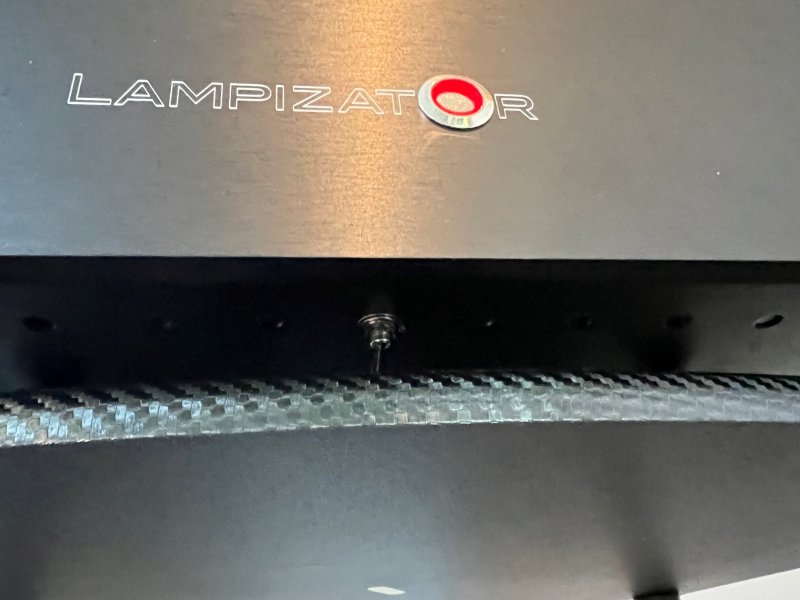
For the gain switch, again I could be wrong, but I think this is a special order item on any Lampi DAC. I had a switch installed on my former GG2, in order to cope with 242 tubes. They installed the toggle switch on the underside of the DAC.

This is a picture from Lampizator when they installed Engine 11-p and the upgraded JL boards in my TRP Dac. You also see the huge Duelund Cast capacitorsThank you for posting your impressions in such great detail- this will be very helpful for future reference!
You mention switching from low gain to high gain. Is this feature exclusive to the SE models only? I use a Golden Atlantic balanced version without volume control and wasn’t aware of this ability/option.
Also- there was a short amount of discussion earlier regarding Engine 11 and its differences to 11-P. I thought it was determined that 11-P was reserved for Poseidon dacs and for those upgrading their Pacific’s. I’d be interested in knowing more details of how these compare in the TRP3.
While I’m not familiar with the GEC or Mullard valves you’ve mentioned I agree with @budburma regarding the KenRad 7193’s. I was able to pick up a quad form the source he recommended and have been using them ever since. They’ve proven to be a very enjoyable tube!
Attachments
Here is a picture of my TRP dac with GEC CV6 and Telefunken RGN2004 mesh, and t picture of the Three types CV6. From left to right: GEC CV6 Shaw (P), GEC CV6 Hammersmith (Z) and Mullard CV6 (red label)Nice report @Wjhen - thank you so much. I can hear your descriptions well.
I'm curious, are your GEC's ST or straight glass? Maybe you can post a pic or two of the GEC's and Mullard's. My ST GEC's and Mullards are more alike than different and more gentlemanly than their american sibling.
I'd encourage you to try some WWII era Ken-Rad 7193's to compare with them. I find the KR to be more dynamic with a deeper still tuneful bass. Also, the Tungsol VT94D has the kind of clarity and delineation you seem to appreciate - it makes sense with large scale orchestral works, too.
I'll shoot you another PM.
Attachments
Last edited:
@Blake @Designsfx yes, in speaking with Rob at Lampizator NA he thinks it’s the transformer with the rectifier at fault. I imagine the adapter was the problem as well. It worked fine previously the Valvo, so it’s hard to point my finger directly at that. Not sure how the tube itself would do that without a faulty adapter, though. The pinout seems pretty specific for that type of tube so it’s hard to imagine a mistake identity. The adapter was from Xuling labs and the tube from a seller I’ve not had problems with the past from Germany.
Bad luck. If not too late, are you sending the adapter with the dac to Poland for testing?
Last edited:
It is and I didn't - I asked if they wanted to test them and got no response - I have a tech nearby that may be able to.Bad luck. If not too late, are you sending the adapter with the dac to Poland for testing?
IN THE MEANTIME, my A3 has made it's way back to my system and sounds great, so I'm happy with that! The transformer was toasted. My tech says it would have had to be a dead short...it's greek to me, but all seems a little mysterious..
AND while it was away I got my VAC modded to accept the large XShadow RCA terminations on my favorite Dynamic Design Nebula TBK IC's. Sounding very sweet over here right now!
Just to make me feel somewhat safer, I got some adapters that didn't break the bank from a builder on Head-Fi. They seem more substantial in some ways and sound fine - maybe a little better than the chinese ones, but I'm not sure I can say...or hear.
Here are some side by sides with the Xulingmrs.
He uses shielded microphone cable and labels the leads, so that helps. Red to the plate (leads interiorly the the outer post) and blue to the grid (interior inner post). The caps fit better. Point to point wiring, no boards. With the 2->1 6j5->6sn7 adapters they can rotate to align however they fit best onto the gear. Groovy looking brushed aluminum.
30 bucks for the pair delivered. Boom.
I have a replacement for the adapter in question on the way - 35usd.
No Zebrano, but hey now.
Attachments
Hey La hey la my Lampi's back....and the tube swapping begins again!
I recently had my integrated modded to accept some interconnects that are very revealing, but smooth at the same time, which had me going back to the old standy RCA 5R4GY to slow things down a bit. It's worked wonders. With other combos of wire, the RCA made things a bit think and slow...mournful almost. BUT with this interconnect I have in place and the KenRad 7193's it provides a roundness while remaining detailed on a very large stage. For now, it's what I'm looking for.
I've gone back and compared the KenRads to the National Union 7193 and Mullard CV6. KenRad is the clear winner there. CV6 a little too warm and less incisive and the NU with a smaller stage and less detaile. I also retried the vaunted Bendix 6384 - still a very nice tube. I could live with either - it's a matter of taste there. I prefer the 7193 for it's slightly less clinical feeling, although overall the 6384 isn't clinical whatsoever and actually has some nice warmth. The KR's have a tiny bit of distortion or overtone that I find attractive. Same big stage, detail, etc.
I think my source, Sound Science Music Vault Ultra modded with SS drives and Pink Faun Ultra AES card/clock, seems to inject a bit of extra energy that I try to balance and tame in various ways. I've tried other sources including Antipodes sources and still liked the Sound Science Cat as much or better - though old, it's really pretty bit perfect and does a wonderful job for me as both server and player.
With so many options for tubes in the Lampi, it's almost impossible to settle on one combo....different music sounds best with different tubes and any up or downstream change makes for a more attractive combo...at least sets a search in motion. Sometimes I think the TRP 'paradise' is like Eden where it seems perfect but a poison apple is there too and the temptation is too much for the OCD in my audiophilia. Like Oscar Wilde said "I can resist anything except temptation.," but then went on: "The only way to get rid of a temptation is to yield to it. Resist it, and your soul grows sick with longing for the things it has forbidden to itself, with desire for what its monstrous laws have made monstrous and unlawful."
I recently had my integrated modded to accept some interconnects that are very revealing, but smooth at the same time, which had me going back to the old standy RCA 5R4GY to slow things down a bit. It's worked wonders. With other combos of wire, the RCA made things a bit think and slow...mournful almost. BUT with this interconnect I have in place and the KenRad 7193's it provides a roundness while remaining detailed on a very large stage. For now, it's what I'm looking for.
I've gone back and compared the KenRads to the National Union 7193 and Mullard CV6. KenRad is the clear winner there. CV6 a little too warm and less incisive and the NU with a smaller stage and less detaile. I also retried the vaunted Bendix 6384 - still a very nice tube. I could live with either - it's a matter of taste there. I prefer the 7193 for it's slightly less clinical feeling, although overall the 6384 isn't clinical whatsoever and actually has some nice warmth. The KR's have a tiny bit of distortion or overtone that I find attractive. Same big stage, detail, etc.
I think my source, Sound Science Music Vault Ultra modded with SS drives and Pink Faun Ultra AES card/clock, seems to inject a bit of extra energy that I try to balance and tame in various ways. I've tried other sources including Antipodes sources and still liked the Sound Science Cat as much or better - though old, it's really pretty bit perfect and does a wonderful job for me as both server and player.
With so many options for tubes in the Lampi, it's almost impossible to settle on one combo....different music sounds best with different tubes and any up or downstream change makes for a more attractive combo...at least sets a search in motion. Sometimes I think the TRP 'paradise' is like Eden where it seems perfect but a poison apple is there too and the temptation is too much for the OCD in my audiophilia. Like Oscar Wilde said "I can resist anything except temptation.," but then went on: "The only way to get rid of a temptation is to yield to it. Resist it, and your soul grows sick with longing for the things it has forbidden to itself, with desire for what its monstrous laws have made monstrous and unlawful."
Similar threads
- Replies
- 23
- Views
- 4K
- Replies
- 105
- Views
- 9K
- Replies
- 21
- Views
- 2K
- Replies
- 1
- Views
- 1K
Members online
- brad225
- andromedaaudio
- exupgh12
- tubes59
- AudioHR
- Cala
- mariusc
- Hear Here
- John T
- SoupRKnowva
- highstream
- WillBthr
- QuadDiffuser
- Bobofei86
- Imperial
- jhulton
- Argonaut
- PurePoor
- Sarge
- tbollier
- bonzo75
- strapper211
- Kris
- skids929
- pdubya
- Dezy
- Raypok
- pattad
- Elberoth
- rDin
- Raysat52
- Geoffkait
- soarsz
- enochRoot
- Dogberry
- unboxed
- Johan K
- Rico25
- Duke LeJeune
- mtemur
- enzo1
- mainelotus
- toronto416
- BCRich1960
- jazzdude99
- GuillaumeB
- Klonk
- sugama
- lscangus
- audiobomber
Total: 893 (members: 81, guests: 812)
| Steve Williams Site Founder | Site Owner | Administrator | Ron Resnick Site Co-Owner | Administrator | Julian (The Fixer) Website Build | Marketing Managersing |











